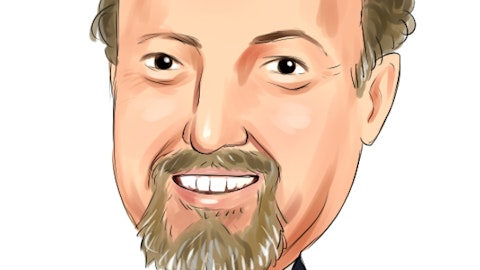Basically, we’re still in the same number of units, but we have more profit per unit. Therefore, there’s more revenue because of higher profitability and less promotional activity. We’ve seen that in other quarters as well. It’s more disciplined approach to how we do promos. So that part should be fairly straightforward. If not, I can follow up if you ask another question. On the zero to two, I think your question was what should sell through be? I would expect sell through to also be roughly 0% to 2%. Effectively we should be ending the year about where we started from a channel inventory standpoint and the operating model is really for us, it’s have a linear business where we’re selling every month, every day, every week, we’re selling. That’s how customers buy.
B2B can be a little different, but generally their customers are buying every day, every month, every week and we want our factories to run that way and ship that way and that matches how customers buy. Now what’s different is, for example, in China there’s a big promo window June 18. So we tip the product into the field in advance of that and that’s this forward weeks on hand operating model. So in China, we’ll be shipping a lot more product in this month, in May, April and May to get ready for that promo window and then it will come down a little bit. As we think about Amazon prime days, we’ll be selling in advance of those days. So all we’re doing now is matching how we fill the channel in advance of the promotional windows, the big one being, Black Friday, the December quarter, the holiday window is the biggest quarter of the year for us.
The December quarter. We’ll start having that fill happening in late September, October, early November, and then again the channel will come out. So all the hard work that we’ve done a year ago now is going to pay fruit and that should mean better margins and lower operating costs, which should translate into a very compelling gross margin of that 41%-ish this year and in that range of 39% to 44% for the years to come.
Erik Woodring: Okay. Very clear and then maybe just as my follow up, Hanneke, just in terms of its felt for a few months now, you’ve emphasized M&A a bit more than your predecessor. Logitech hasn’t really made a large acquisition and I’d say over a decade, at least one that would move the needle and you have very clearly spent a lot on shareholder returns and so I guess, big picture, is it your view you’re going to lean more into what I would call transformational M&A prior, more than prior executives? Is that how the board is thinking about this? Is this how shareholders are thinking about the future? And would that still be incremental to your capital returns, or would that capitalize, excuse me, cannibalize some of what you’ve been returning to shareholders? Obviously a very strong balance sheet, but just how should we think about those different dynamics going forward? Thank you so much.
Hanneke Faber: Sure. Thanks, Eric. I can’t speak for my predecessor. What I’m hoping to get across here is that our priority right now is organic growth. That’s why we’re guiding the low single digits grow into mid-single digits. That’s what’s under our control. Now, on top of that, with our balance sheet, we do have opportunity for M&A. The key is that that is thoughtful, deliberate and strategic. Size is a factor, but it’s just one of many factors. What’s more important is that we’re really thoughtful because what I’ve learned over the years is doing the deal is really easy. Making it a success is much harder. So organic growth is what is our number one priority at the moment, but if there’s good M&A opportunities, we won’t hesitate to take advantage.
Nate Melihercik: Thanks, Eric. Our last question today is from Michael Foeth at Vontobel. Hello, Michael.
Michael Foeth: Yes, hi. Thank you. Two questions from my side. You mentioned the expansion of your sort of mice keyboards or work business into or outside of the office. Can you maybe be a bit more specific what sort of applications you have in mind there and how that should significantly increase your addressable market? And the second question is regarding your brand strategy. I was wondering how and when you plan to phase out those brands like UE and Logitech G and you name them, all the sub brands, if you want?
Hanneke Faber: Great. Let me take that second one first, because I can be quite brief. We are not phasing out Logitech G. So Logitech G is Logitech. And the G stands for gaming, which makes sense. So if I insinuated that, I was not clear. So Logitech and Logitech G are very much part of the same mother brand and we’re going to do our darn as best to make those iconic. 97% of Logitech’s revenue today is in Logitech and Logitech G. So the multi brand strategy was a big talking point, but in reality, most of it is actually Logitech and Logitech G. So that’s where our focus will be. Great question on work. So again, most people in the work world don’t work in offices. So we are starting to put our toes into the water on some of these other spaces that I talked about.



